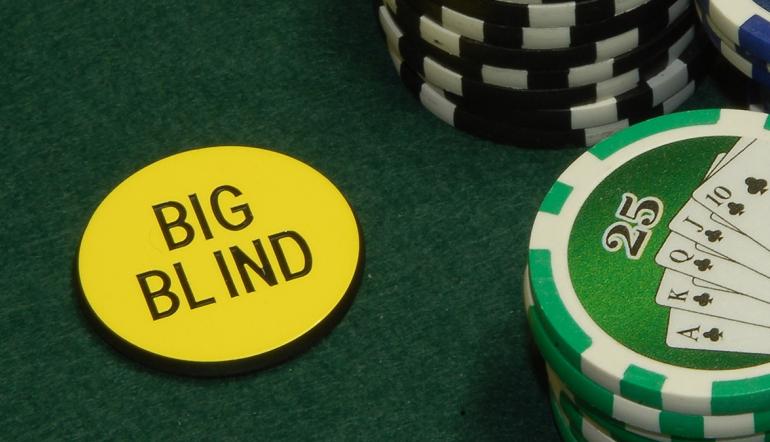Heads Up Poker Rules Big Blind
This time we shall cover one of the most awkward and misplayed situations in the Spin & Go: the 10-15 big blind stack.

Who Is the Big Blind Who Is the Small Blind in Heads-Up Poker? This is the most common question I get about 2 player poker. The big blind is always the player who does not have the dealer button in front of him or her. That means that the person dealing is always the small blind. Introduction to Heads Up SNG Poker. Heads-up sit and go tournaments are played with two players, the small-blind being assigned to one player, and the big-blind to the other. Poker Rules; Poker Strategy; Poker Faces; Poker Downloads; Help; Blog; Poker Bonus Codes; How to Play Head's-up Effectively when You are the Big Blind, Pre-Flop? If the other player merely calls your blind, you need to raise back about twice the size of the blind if you have a good hand, because your foe may be trying to sneak in and see the. Why aggression is important in heads-up poker. Concepts to bear in mind on each street; Heads-up No-Limit Hold'em requires the mastery of all the classic elements of poker - maths, psychology, hand reading and heart. For players craving action and the ultimate test of their skills, heads-up poker has always been the game of choice. Heads up poker is the purest form of the game and is one of the most profitable game types for skilled players. Heads up poker format means that you will have to play the blind every hand and hence will have to play LOTS of hands - in some cases 100% of the hands you are dealt.
The Final Raise
Being able to put the final raise in is advantageous because it guarantees us both fold equity and the ability to realise all of our equity by seeing all five community cards. Of course, putting the final raise in is really only an effective idea when that raise represents a reasonably small investment compared to the pot-size. Having to risk 20x the pot in order to get the last say is usually not worth it.
Back in Episode 2, we built a min-raise or fold game on the BU with 25BB. The favourable thing about this stack-size was that after we raised to 2BB, there was no overly effective 3-bet size for the players in the blinds to adopt. We saw that a shove offered them a poor risk to reward ratio and allowed us to fold many hands without being exploited. We also saw that the small 3-bet was a fairly bad idea with any hand that is not nutted or happy to fold to a 4-bet jam. In other words, there was no effective way for our opponents to make the final raise. As a result, we chose the min-raise as our sole way of entering the pot.
Heads Up as the BU
Now to today’s topic. One player has been eliminated and we find ourselves heads-up on the BU with 12-15BB. The problem with min-raising now is that when we make it 2BB, Villain has a very good risk reward ratio in the form of a shove. He can put in the final raise at a reasonable cost, risking only 4-5x the pot, forcing us to either play with no fold equity or fold. This dramatically shrinks the numbers of hands we can get all-in with profitably. If we were making the final raise, many more hands would become profitable shoves. The effectively sized final raise is a big deal and we should pre-plan the stack to pot ratio to make sure that it is us and not Villain who will have this luxury.

Let’s say the effective stack (the lower of the two players’ stacks) is 12BB. Raising to 2BB offers Villain a very effective shove and we would have to considerably tighten our min-opening range beyond the point where it is worth building one, in order to defend enough combinations.
The first antidote to this problem is to build a limping range. We do not want to be forced to shove or fold a hand like QTo, we would rather play a pot against a wide range. If Villain raises small, we can call. If he shoves, we can fold safely in the knowledge that his final raise is too large to be effective and that we can fold frequently against it without exploitation. Of course, we will choose to shove some hands against a small raise both for value and as a reasonably high equity bluff. We might also choose to slow-play very big pairs like QQ+ here by limp/calling, but this is less true for vulnerable hands like [88-JJ] that would rather deny equity. There will also be hands we limp and simply fold to a small raise and these will be combos with some small merit that cannot afford to make much of a pre-flop investment; Q3s and 87o come to mind.

The second remedy to the final raise problem at 12BB stacks is to develop an open-shove range. This should consist of hands which have decent equity when called but detest playing flops and trying to make their way to showdown on a lot of board textures. Open-jamming A3s, A8o, and 44 is good for this reason. We can also choose to open-jam large off-suit aces like AJo-AKo. These can easily be favourites when called and can be seen as less flop-friendly value hands that prefer to see always all five cards when they invest money.
Here is the overall construction of our BU strategy at 12BB stack depth:
Exploiting
Exploitatively speaking, this is one of the most lucrative situations in the Spin & Go. As we have already noted, these tournaments are full of weaker players who have nothing like a refined pre-flop strategy heads-up on the BU. You will come across players who limp only with hands they are intending to limp/fold. You will find ones who 3x the BU with 100% of hands allowing you the most profitable final raise imaginable. You will even find players who fold 60-70% of their hands as the BU in this situation.
The upshot is that we should not assume our opponents are playing anything like the strategy we have learned in this article. When the tournament goes heads-up you should already have a general profile of the remaining opponent. You will be able to tell a regular from a mile away. As soon as you see frequent BU min-raising three handed and a shove or fold game in the SB facing a BU raise there is a very high likelihood the player is at least semi-competent. On the other hand, if Villain has been limping his BU three handed at the start of the Spin & Go, raising 3-4x the BB, or flatting BU opens from the SB, there is a high chance that he will turn out to be a predictable passive weaker player – the most common type of recreational out there. In this case you can probably get away with limping in 100% of hands heads-up on the BU without punishment.
Keep your eyes open. These ranges are for your own use; your opponents probably have not seen them. You will win more often by noting how your opponents accidentally deviate from them.
Conclusion
The Spin & Go requires a lot of switching between different gears as the effective stack changes relative to the size of the big blind. Being able to effortlessly change from mode to mode is what separates a strong player from an average one. Look out for how your opponents fail to make these adjustments and try to take advantage. We will finish up this series by looking at even shorter stack play at the very end of the tournament.
Join us on our Discord channel.
In order to start betting in Hold’em, forced bets (known as blinds) are made by the two players immediately clockwise from the dealer button. The person immediately clockwise from the dealer has the small blind, and the next player clockwise has the big blind. Making blind bets is known as posting and this is done before any cards are dealt.
What Is A Poker Blind
The size of the bets are determined by the limits of the game that you’re playing and the small blind is nearly always half of the big blind. So a $2/$4 Limit Hold’em game has a small blind of $1 and a big blind of $2.
Blinds are forced bets. The players in these positions must make these bets or they aren’t dealt cards in the hand. These blinds, in turn, force betting action on the table after everyone has been dealt their hole cards.
At a casino, when you first sit down at a Hold’em table, the rules vary as to whether you have to post blinds (even if you’re out of the normal blind positions for that hand) in order to be dealt a hand.
Heads Up Poker Big Blind
In Las Vegas, you’re dealt a hand as soon as you sit down and have shown that you meet the table’s minimum buy-in. You’re not required to post a blind in order to get hole cards. Conversely, in most California card rooms, you’re required to post a big blind in order to get your starting hand.
In cases where you’re required to post a big blind before you’re dealt cards, you’re mildly better off just waiting until it would normally be your turn to get the big blind anyway, rather than jumping straight into the hand. Waiting like this keeps you from making an extra forced bet and gives an added bonus of being able to case the players at the table while you aren’t actually playing. Dealers are used to this behavior and will probably ask you if you want to sit out (that is, wait until it’s your turn to post the big blind).
Poker Big Blinds

How soon you post is a fine point, though, that doesn’t really make that much difference. If you’re itchin’ to play, or if you have a very limited amount of time to play, go ahead and jump in. The dealer will tell you whether you’re required to post a big blind.